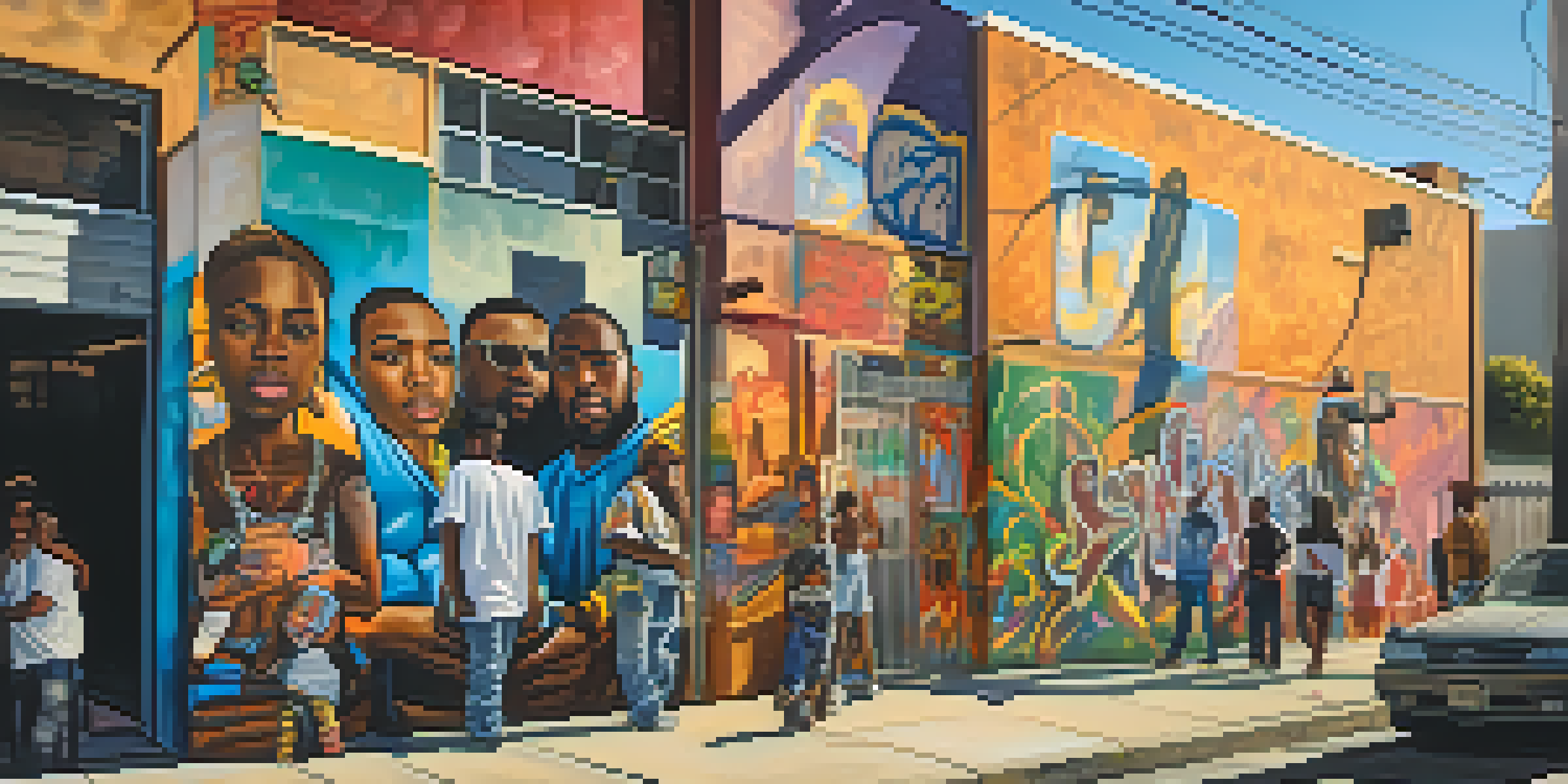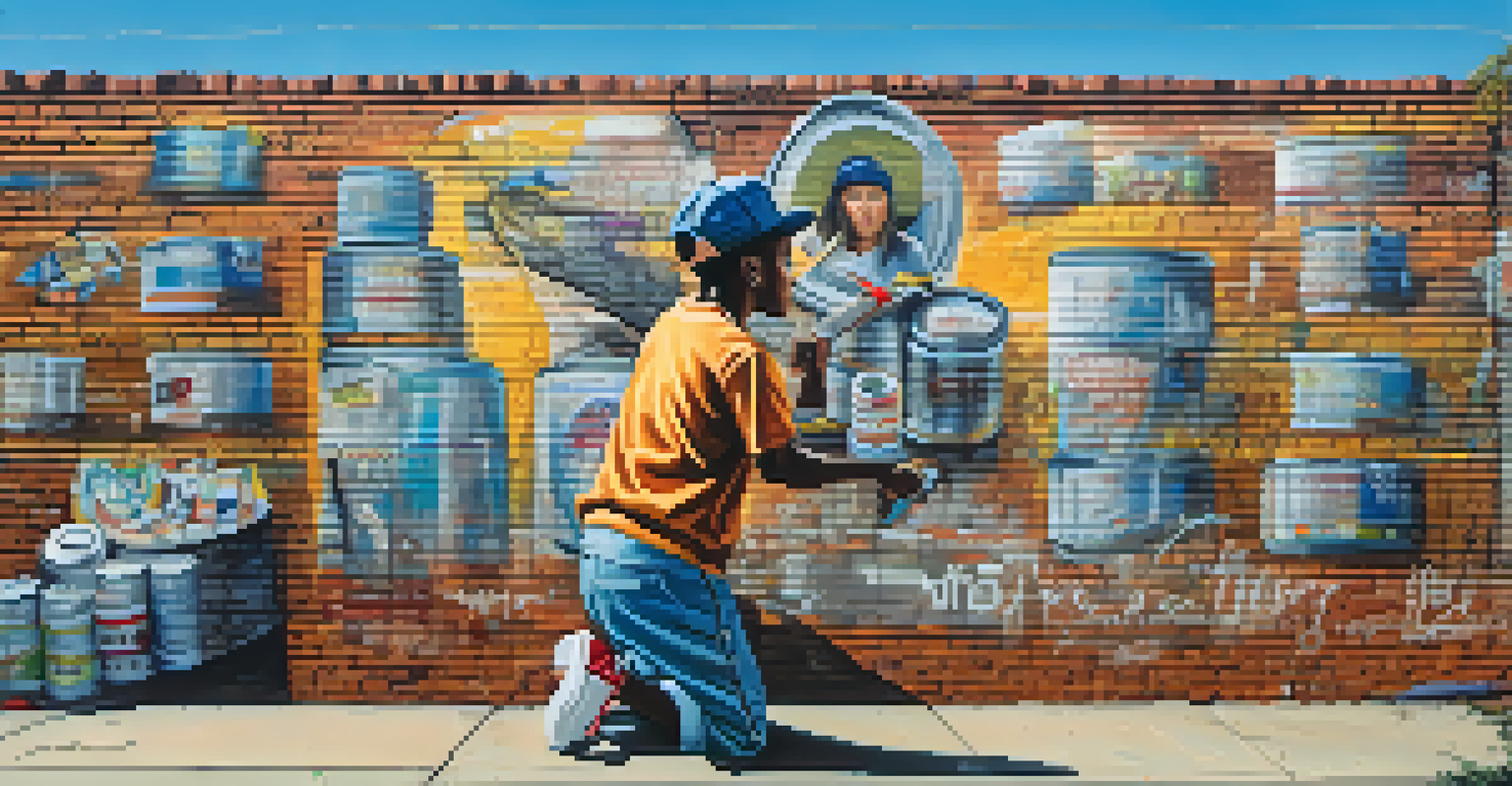The Gangsta Rap Aesthetic: Compton's Visual Influence

Understanding the Roots of Gangsta Rap Aesthetic
Gangsta rap emerged in the late 1980s, primarily from Compton, California. This genre of hip-hop brought with it a raw, unfiltered look at street life, crime, and resilience. Artists like N.W.A and Ice Cube used their music as a platform to highlight the struggles faced by their communities, which resonated with listeners across the globe.
Music is a weapon for me. It's a weapon of mass communication, a weapon of change.
Visually, the gangsta rap aesthetic is characterized by gritty imagery, urban landscapes, and a rebellious attitude. This reflection of reality was not just limited to music videos but extended to street art, fashion, and even graffiti. The visuals served as a powerful statement about the environment these artists came from, creating an authentic connection with their audience.
As the genre evolved, so did its visual representation. The influence of Compton's aesthetics can be seen in various forms of media, including film and photography, where the street culture is often romanticized yet remains rooted in its harsh truths.
The Role of Iconic Imagery in Shaping Perceptions
Iconic imagery from Compton artists has played a significant role in shaping public perception of gangsta rap. The visuals often depict themes of violence, struggle, and survival, which can both captivate and alienate audiences. For instance, the album cover of N.W.A's 'Straight Outta Compton' features a stark image that captures the essence of the streets, making it impossible to ignore.

These images contribute to a broader narrative that extends beyond music, influencing fashion trends and lifestyle choices among fans. The black-and-white photographs of artists posing with their crew, often in front of graffiti-covered walls, evoke a sense of authenticity and pride in their roots. This imagery has cemented itself into the cultural fabric of hip-hop.
Gangsta Rap's Authentic Aesthetic
The gangsta rap aesthetic combines raw visuals and music to authentically represent the struggles of urban life.
However, this aesthetic also raises questions about the glorification of violence and the stereotypes associated with it. While many artists aim to tell their story, others criticize how these visuals can perpetuate negative perceptions of communities like Compton.
Fashion and Style: A Reflection of Street Culture
Fashion is a crucial aspect of the gangsta rap aesthetic, reflecting the identity and lifestyle of its artists. Baggy jeans, oversized shirts, and baseball caps became staples in the fashion scene, often seen as symbols of rebellion against mainstream culture. This style was not just about clothing; it was a way for artists to express their connection to their roots.
Art is a reflection of our society. It tells the stories we often don't want to hear.
Brands like Dickies and Champion found a new audience as they were embraced by the hip-hop community, turning workwear into high fashion. The unique blend of practicality and style helped define a generation, creating a visual language that communicated toughness and authenticity. Compton artists played a pivotal role in this transformation, showcasing how fashion could serve as a form of resistance.
Moreover, the influence of this fashion extends beyond music videos; it has permeated popular culture, appearing in movies, TV shows, and even high-profile fashion runways. The aesthetics of Compton continue to inspire new generations, merging street culture with mainstream fashion.
Graffiti: The Art of Expression in Compton
Graffiti serves as a powerful visual element within the gangsta rap aesthetic, representing both art and activism. In Compton, walls are canvases that tell stories of community struggles, triumphs, and identity. Artists like N.W.A have often referenced graffiti in their music, emphasizing its role in expressing the unfiltered voice of the streets.
The vibrant colors and bold letters of graffiti create a stark contrast to the often bleak realities depicted in gangsta rap. This form of art not only beautifies the urban landscape but also serves as a means of communication among locals. It reflects the culture and history of the community, making it an integral part of the visual narrative surrounding gangsta rap.
Cultural Impact Beyond Music
Iconic imagery and fashion from gangsta rap have influenced broader cultural trends, shaping perceptions and lifestyles.
However, graffiti can also be viewed through a controversial lens, as it raises questions about legality and public space. While some see it as vandalism, others argue it is an essential expression of cultural identity, much like the music that originates from the same streets.
Film and Documentaries: Bringing Compton's Stories to Life
The aesthetic of gangsta rap has significantly influenced film and documentaries, with Compton often serving as a backdrop for these narratives. Movies like 'Straight Outta Compton' not only depict the rise of iconic artists but also capture the essence of life in Compton during the late 20th century. This cinematic portrayal brings the raw realities of the streets to a broader audience.
Documentaries exploring the lives of gangsta rap artists further enrich the visual narrative, providing insights into their struggles and triumphs. Through interviews and archival footage, these films highlight how music and visuals are intertwined with the socio-economic conditions of the time. They serve as both an education and a celebration of the culture.
The impact of these films extends beyond entertainment, sparking conversations about race, inequality, and the power of music as a tool for change. They illustrate how the gangsta rap aesthetic shapes perceptions of Compton, revealing the complexity of its culture and the stories that often go untold.
Influence on Contemporary Artists and Culture
The gangsta rap aesthetic has left a lasting legacy that continues to influence contemporary artists today. Modern musicians often draw inspiration from the visuals and themes pioneered by Compton artists, weaving them into their own narratives. This connection illustrates how powerful storytelling can transcend generations and maintain relevance.
Artists like Kendrick Lamar and YG reflect on their roots, incorporating elements of the gangsta rap aesthetic into their music and visuals. This blend of old and new creates a rich tapestry that honors the past while pushing the boundaries of hip-hop. Their work demonstrates how Compton's influence remains potent in shaping the cultural landscape.
Evolving Visual Narratives
New technologies and platforms are enabling contemporary artists from Compton to redefine and share their visual stories.
Furthermore, the aesthetic has permeated various aspects of popular culture, including fashion, art, and social movements. The visuals associated with gangsta rap have become symbols of resistance and empowerment, resonating with audiences far beyond the boundaries of Compton.
The Future of Compton's Visual Influence
As the music industry evolves, so does the visual landscape associated with gangsta rap. New technologies and platforms provide artists with innovative ways to share their stories, allowing for greater creativity in visual representation. This opens up opportunities for emerging artists from Compton to redefine the aesthetic while staying true to their roots.
Social media plays a crucial role in this evolution, enabling artists to connect directly with their audience and share their visual narratives. Platforms like Instagram and TikTok have become vital tools for showcasing the gangsta rap aesthetic in real-time, where street culture can thrive and adapt. This democratization of content creation allows for diverse voices to emerge.

The future of Compton's visual influence looks promising, with younger generations taking the helm and exploring new forms of expression. As they blend traditional elements with contemporary styles, they ensure that the essence of gangsta rap continues to resonate and evolve, representing both the struggles and triumphs of their communities.